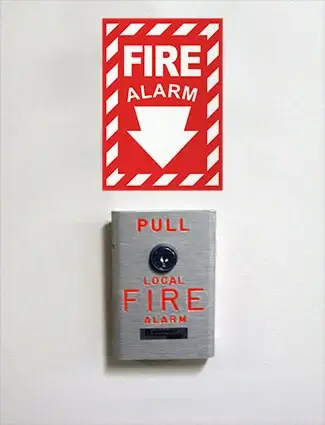OSHA Fire Safety Rules That Could Save Lives and Property

How Can Businesses Prevent Workplace Fire Hazards?
In any workplace, fire safety is not just a box to tick—it is about keeping your team out of harm's way. The Occupational Safety and Health Administration (OSHA) requires that businesses must have a written fire prevention plan to safeguard employees against fire-related incidents. This is a core part of OSHA compliance, ensuring that organizations proactively manage risks before they escalate.
Workplaces with 10 or fewer employees are the only exception to this rule. Without such a plan, businesses risk higher chances of injury, loss of life, and significant property damage during a fire emergency—outcomes that violate key OSHA requirements for workplace safety.
In 2023, the National Fire Protection Association (NFPA) reported around 118,000 nonresidential building fires in the United States. These fires caused:
- 150 deaths
- 1,300 injuries
- $3.3 billion in direct property damage
These alarming figures underscore the urgent need for thorough fire prevention protocols and adherence to OSHA regulations in all workplaces.
Creating a Fire Prevention Plan That Meets OSHA Requirements
To ensure workplace safety and maintain OSHA compliance, every organization must develop a comprehensive fire prevention plan. These plans must meet specific OSHA requirements outlined in OSHA standard 29 CFR 1910.39, which detail how to minimize fire hazards and protect workers.
According to OSHA, a fire prevention plan must include the following critical elements:
- Identify major fire hazards: List all major fire hazards in your workplace. Include detailed procedures for handling and storing flammable materials, identify potential ignition sources, and specify the necessary fire protection equipment to control each hazard.
- Control flammable waste: Establish clear procedures to manage and dispose of flammable and combustible waste materials. Regularly removing these materials minimizes the risk of fire.
- Maintain heat-producing equipment: Implement a schedule for the regular maintenance of safeguards on all heat-producing equipment. This helps prevent the accidental ignition of combustible materials.
- Assign responsibility for equipment maintenance: Designate specific employees by name or job title to be responsible for maintaining equipment. These individuals will focus on preventing or controlling potential fire ignition sources.
- Assign responsibility for fuel source control: Identify employees responsible for controlling fuel source hazards. This ensures there are dedicated personnel managing the risks associated with fuel sources.
While these 5 requirements are the minimum for a fire prevention plan, there are still other components worth including in a plan to better limit a fire from starting. Below are those elements a fire prevention plan should incorporate.
Defining Employee Roles in Fire Prevention
Every worker has a range of responsibilities to support fire safety protocols. These may include scheduling inspections for sprinkler and fire suppressant systems. The fire prevention plan should specify who is responsible for storing, monitoring, and maintaining flammable materials, as well as who oversees employee training and how that training is tracked.
Fire Hazard Classes and Material Categories
Accurately classifying materials is critical for workplace safety and a foundational part of meeting OSHA labeling requirements. Proper identification supports effective hazard communication and helps prevent fire-related incidents.
Here are the standard material classifications:
- Class A: Ordinary combustibles such as wood, paper, and cloth
- Class B: Flammable gases, liquids, and greases
- Class C: Electrical equipment or materials near electrically powered equipment
- Class D: Volatile metals such as magnesium, zirconium, potassium, and sodium
Clearly labeled storage areas and containers ensure alignment with OSHA compliance protocols. Using consistent, visible signage and labels—especially those designed for industrial environments—can significantly reduce the risk of misidentification or mishandling of hazardous materials.
Facilities must also understand and follow NFPA guidelines for the storage of hazardous materials. Materials that can contribute to the flammability of others—such as oxidizers and peroxides—should be stored in areas separate from flammable substances to reduce risk.
How to Eliminate Common Ignition Sources in the Workplace
Remove all non-essential ignition sources where employees store or use flammable materials.
Key preventive measures include:

- Ensure open flame sources (heaters, welding torches, or ovens) are away from operations involving flammables.
- Do not allow the storage or handling of flammable materials in areas where chemical ignition sources (switches and circuit breakers) are operating.
- Sparking tools must not be allowed in areas where employees store or handle flammables.
- Cutting or welding operations cannot contact flammable liquid containers.
These practices support both hazard elimination and compliance with OSHA standards for fire prevention. Facilities should also review OSHA labeling requirements to make sure fire hazard zones are clearly marked to prevent accidental ignition.
Selecting, Placing, and Maintaining Fire Extinguishers
Designated employees or management personnel should receive training on how to use fire extinguishers effectively. These tools can be critical for extinguishing fires in their early stages. Properly labeled and well-maintained extinguishers have saved lives and property. The selection, inspection, and maintenance of fire extinguishers are essential to their effectiveness. Organizations should appoint individuals or teams responsible for placing extinguishers in conspicuous, easily accessible locations and for ensuring they remain fully charged and operable.
Daily Practices That Reinforce Fire Safety Compliance
Designated individuals, typically a safety committee or supervisors, are responsible for compliance with the company's fire safety programs and communicating procedures with all employees. Housekeeping, access to fire extinguishers, emergency evacuations, and proper storage of chemicals, are addressed when regular inspections take place.
Keeping Emergency Exits Clear, Marked, and Accessible
Exits need to be clearly marked as fire or emergency exits and be easily accessible. They should never be obstructed. All doors or passageways that do not lead to an exit—such as those used for storage, restrooms, or break rooms—must be clearly identified. Exit signs must be either self-illuminating or illuminated by an external light source.
For employees with disabilities, supervisors are responsible for providing assistance during an emergency evacuation. An alternate must also be designated in case the primary supervisor is unavailable. The company is responsible for maintaining an up-to-date list of employees requiring assistance, stored with the HR or Safety Manager.
Fire Emergency Procedures if a Fire Breaks Out
Any employee who discovers a fire should immediately activate the nearest alarm to notify all building occupants.

Fires should only be fought if the fire department has been notified, the fire is small and contained, and the individual attempting to extinguish it has a clear escape route with their back to the exit. A proper, fully functioning fire extinguisher may be used only by personnel who have received appropriate training.
When a fire alarm sounds, all personnel must evacuate their work areas, close windows and doors, and shut off any gas jets if applicable. Once all individuals have assembled at the designated fire emergency area, a roll call should be conducted to verify that everyone is accounted for.
Fire safety in the workplace is a critical component of overall risk management, and adherence to OSHA’s fire prevention guidelines is essential. A comprehensive fire prevention plan not only ensures OSHA compliance but also protects lives and property. Regular training, clearly defined responsibilities, and well-maintained equipment are essential elements of an effective fire safety strategy. By prioritizing fire prevention, businesses can foster a safer work environment and significantly reduce the likelihood of catastrophic fire-related incidents.
DuraLabel Fire Safety Solutions to Meet OSHA Regulations
DuraLabel offers comprehensive fire safety solutions tailored to enhance workplace safety and ensure compliance with OSHA’s fire prevention regulations. Our range of products includes durable, high-quality signs, labels, and printers engineered for fire safety applications. These solutions enable organizations to effectively communicate fire safety procedures, identify emergency exits, and mark fire-fighting equipment locations.
The DuraLabel Kodiak Max Industrial Sign and Label System is a complete in-house industrial label printer designed to meet all fire safety labeling needs. By integrating DuraLabel products into your fire safety plan, you ensure clear, consistent, and compliant safety communication throughout your facility. This supports key aspects of OSHA’s fire prevention requirements, such as identifying major fire hazards, managing flammable waste, and maintaining heat-producing equipment.
Download our free OSHA Signage Quick Start Guide to guarantee your facility is OSHA compliant. This invaluable resource provides a site inspection checklist to ensure that all fire safety elements are thoroughly addressed.
For expert assistance in crafting a fire safety communication system that meets your needs, Call 1-888-402-8820. Our specialists will guide you through the process to ensure your facility's fire prevention measures are robust and effective.
Read Next:
Floor Marking That Improves Fire Safety and Compliance
Related Resources

What is HazCom? Your Guide to Chemical Labeling, GHS, & OSHA Standards
What Is OSHA’s Hazard Communication Standard (HazCom)? "HazCom" is short for "Hazard Communication," OSHA’s ...
Read
GHS-Compliance: Safe and Effective Storage of Hazardous Chemicals
The Importance of the GHS When working with and storing hazardous chemicals, steps must be taken to ensure ...
Read
UN Revises GHS to Clarify Language
A UN panel has made an update to its Globally Harmonized System of Classification and Labeling of Chemicals. ...
Read.png)





